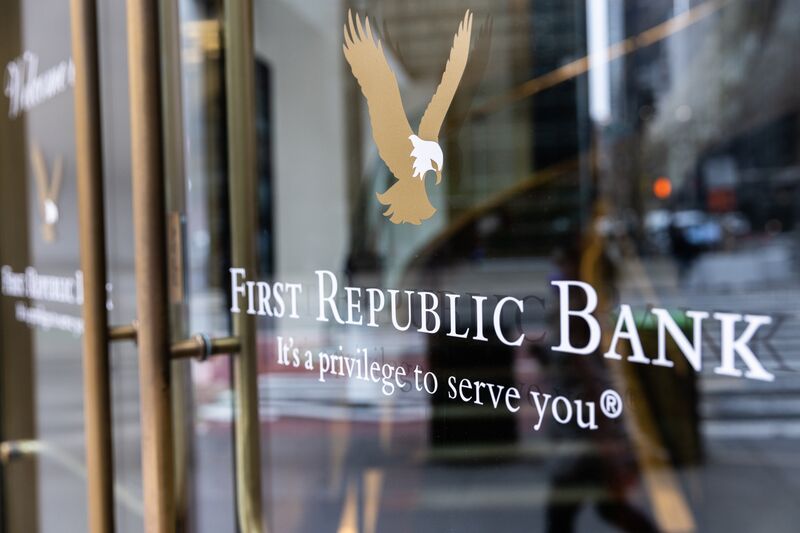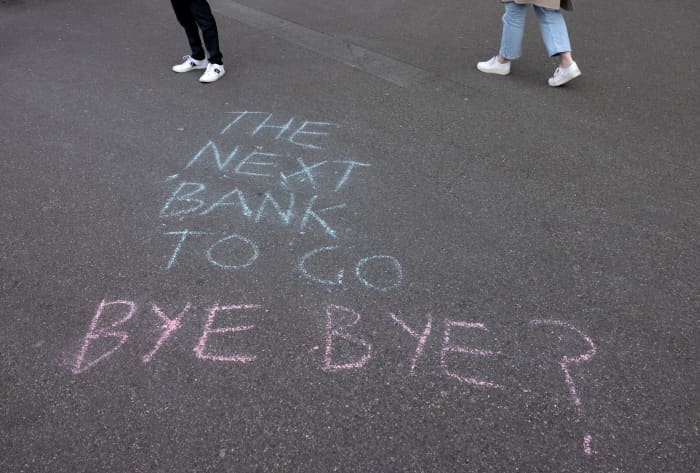You are using an out of date browser. It may not display this or other websites correctly.
You should upgrade or use an alternative browser.
You should upgrade or use an alternative browser.
FDIC shuts down Silicon Valley Bank, crash incoming? Update: 2nd bank, Signature Bank in NY closed
- Thread starter Paper Boi
- Start date
More options
Who Replied?
Last edited:
US Mulls More Support for Banks While Giving First Republic Time
- Changes to Fed’s liquidity program could be made to help bank
- Even without that, officials are letting it continue deal hunt

A First Republic Bank branch in New York.
Photographer: Jeenah Moon/Bloomberg
By
Katanga Johnson and
Saleha Mohsin
March 25, 2023 at 12:32 PM EDT
US authorities are considering expanding an emergency lending facility for banks in ways that would give First Republic Bank more time to shore up its balance sheet, according to people with knowledge of the situation.
Officials have yet to decide on what support they could provide First Republic, if any, and an expansion of the Federal Reserve’s offering is one of several options being weighed at this early stage. Regulators continue to grapple with two other failed lenders — Silicon Valley Bank and Signature Bank — that require more immediate attention.
Even short of that step, watchdogs see First Republic as stable enough to operate without any immediate intervention as the company and its advisers try to work out a deal to shore up its balance sheet, the people said, asking not to be named discussing confidential talks.
First Republic’s stock has plunged more than 90% this month amid concerns that the San Francisco-based lender could fall victim to the same forces that recently caused a trio of US banks to collapse. But while those banks toppled when rapid customer withdrawals forced them to lock in losses on depreciated assets, First Republic has remained open and independent.
Keeping Tabs
US officials have been keeping close tabs on the firm’s health and progress — aiming to stay vigilant in case the situation unexpectedly changes.Behind the scenes, they have concluded the bank’s deposits are stabilizing and that it isn’t susceptible to the kind of sudden, severe run that prompted regulators to seize Silicon Valley Bank within just a few days, the people said.
Though First Republic has structural problems with its balance sheet, it has cash to meet client needs while it explores solutions, the people said. That includes $30 billion deposited by the nation’s largest banks this month.
Representatives for the Fed, FDIC and First Republic declined to comment. The Treasury Department had no immediate comment.
A potential adjustment to the Federal Reserve’s emergency lending program announced on March 13 is among options authorities have weighed in recent days, according to people with knowledge of the deliberations.
Any expansion of the Fed’s liquidity offerings would apply to all eligible users, in keeping with banking law that says remedies must be broadly based, rather than aimed at helping a particular bank. But the change could be made in a way to ensure that First Republic benefits, the people said.
null
...
bro babble. big miners / 50.x% of the network just needs to accept the new software.
also not factoring in the technology. at all.
CNBC just deleted 5 pages showing the current and historical 5 year Credit Default Swaps for:
- JPMorgan, deleted URL: https://www.cnbc.com/quotes/JPMCD5
- Bank of America, deleted URL: https://www.cnbc.com/quotes/BACCD5
- PNC, deleted URL: Check out PNC Financial CDS 5-Yr's stock price (PNCCD5) in real time
- Truist Financial, deleted URL: Check out Truist Financial CDS 5-Yr's stock price (TFCCD5) in real time
- Wells Fargo, deleted URL: https://www.cnbc.com/quotes/WFCCD5
Not deleted: Goldman Sachs Check out 's stock price (GSCD5) in real time, Deutsche Bank Check out 's stock price (DBCD5) in real time .
You can easily use archive.org to check for yourself example:

Check out 's stock price (BACCD5) in real time
Get Bank of America CDS 5-Yr (BACCD5: ) real-time stock quotes, news, price and financial information from CNBC.web.archive.org
This might not seem like a big thing, but it is! This was one of the very few sources were you could see current credit default swaps data online. I would love to get an explanation from CNBC.
EDIT: I was actively crawling the pages in question, it did work until at least Friday, 24 March 2023 23:55:35 after that the crawling paused for the weekend as the markets are closed. So this change occurred during the weekend.
the bossman
Superstar
'Taxpayers won't pay a dime.' he said
Except in new trickled down bank fees

null
...
"Tax payers won't pay for this
 "
"
'Most U.S. banks are technically near insolvency, and hundreds are already fully insolvent,' Roubini says
Bank sector stress makes a stagflationary debt crisis more likely and severe, writes Nouriel Roubini.
Opinion: ‘Most U.S. banks are technically near insolvency, and hundreds are already fully insolvent,’ Roubini says
Last Updated: April 1, 2023 at 8:06 a.m. ETFirst Published: March 31, 2023 at 7:05 a.m. ET
By
Nouriel Roubini
Bank-sector stress makes a stagflationary debt crisis more likely and potentially more severe

Duration risk hammered Silicon Valley Bank and seems to have been lost on many bankers, fixed-income investors and bank regulators.
In January 2022, when yields on U.S. 10-year Treasury bonds TMUBMUSD10Y, 3.471% were still roughly 1% and those on German Bunds were -0.5%, I warned that inflation would be bad for both stocks and bonds.
Higher inflation would lead to higher bond yields, which in turn would hurt stocks as the discount factor for dividends rose. But, at the same time, higher yields on “safe” bonds would imply a fall in their price, too, owing to the inverse relationship between yields and bond prices.
This basic principle — known as “duration risk” — seems to have been lost on many bankers, fixed-income investors, and bank regulators. As rising inflation in 2022 led to higher bond yields, 10-year Treasurys lost more value (-20%) than the S&P 500 SPX, +1.44% (-15%), and anyone with long-duration fixed-income assets denominated in U.S. dollars DX00, +0.10% or euros USDEUR, -0.27% was left holding the bag.
The consequences for these investors have been severe. By the end of 2022, U.S. banks’ unrealized losses on securities had reached $620 billion, about 28% of their total capital ($2.2 trillion).
Making matters worse, higher interest rates have reduced the market value of banks’ other assets as well. If you make a 10-year bank loan when long-term interest rates are 1%, and those rates then rise to 3.5%, the true value of that loan (what someone else in the market would pay you for it) will fall. Accounting for this implies that U.S. banks’ unrealized losses actually amount to $1.75 trillion, or 80% of their capital.
The “unrealized” nature of these losses is merely an artifact of the current regulatory regime, which allows banks to value securities and loans at their face value rather than at their true market value.
In fact, judging by the quality of their capital, most U.S. banks are technically near insolvency, and hundreds are already fully insolvent.
To be sure, rising inflation reduces the true value of banks’ liabilities (deposits) by increasing their “deposit franchise,” an asset that is not on their balance sheet. Since banks still pay near 0% on most of their deposits, even though overnight rates have risen to 4% or more, this asset’s value rises when interest rates are higher. Indeed, some estimates suggest that rising interest rates have increased U.S. banks’ total deposit-franchise value by about $1.75 trillion.
If depositors flee, the deposit franchise evaporates, and the unrealized losses on securities become realized. Bankruptcy then becomes unavoidable.
But this asset exists only if deposits remain with banks as rates rise, and we now know from Silicon Valley Bank and the experience of other U.S. regional banks that such stickiness is far from assured. If depositors flee, the deposit franchise evaporates, and the unrealized losses on securities become realized as banks sell them to meet withdrawal demands. Bankruptcy then becomes unavoidable.
Moreover, the “deposit-franchise” argument assumes that most depositors are dumb and will keep their money in accounts bearing near 0% interest when they could be earning 4% or more in totally safe money-market funds that invest in short-term Treasurys. But, again, we now know that depositors are not so complacent. The current, apparently persistent flight of uninsured — and even insured — deposits is probably being driven as much by depositors’ pursuit of higher returns as by their concerns about the safety of their deposits.
In short, after being a non-factor for the past 15 years — ever since policy and short-term interest rates fell to near-zero following the 2008 global financial crisis — the interest-rate sensitivity of deposits has returned to the fore. Banks assumed a highly foreseeable duration risk because they wanted to fatten their net-interest margins. They seized on the fact that while capital charges on government-bond and mortgage-backed securities were zero, the losses on such assets did not have to be marked to market. To add insult to injury, regulators did not even subject banks to stress tests to see how they would fare in a scenario of sharply rising interest rates.
The economy is falling into a ‘debt trap.’
Now this house of cards is collapsing. The credit crunch caused by today’s banking stress will create a harder landing for the U.S. economy, owing to the key role that regional banks play in financing small- and medium-size enterprises and households.
Central banks therefore face not just a dilemma but a trilemma. Owing to recent negative aggregate supply shocks — including the COVID pandemic and the war in Ukraine — achieving price stability through interest-rate hikes was bound to raise the risk of a hard landing (a recession and higher unemployment). But, as I have been arguing for over a year, this vexing tradeoff also features the additional risk of severe financial instability.
Borrowers are facing rising rates — and thus much higher capital costs — on new borrowing and on existing liabilities that have matured and need to be rolled over. But the increase in long-term rates is also leading to massive losses for creditors holding long-duration assets. As a result, the economy is falling into a “debt trap,” with high public deficits and debt causing “fiscal dominance” over monetary policy, and high private debts causing “financial dominance” over monetary and regulatory authorities.
As I have long warned, central banks confronting this trilemma will likely wimp out (by curtailing monetary-policy normalization) to avoid a self-reinforcing economic and financial meltdown, and the stage will be set for a de-anchoring of inflation expectations over time. Central banks must not delude themselves into thinking they can still achieve both price and financial stability through some kind of separation principle (raising rates to fight inflation while also using liquidity support to maintain financial stability). In a debt trap, higher policy rates will fuel systemic debt crises that liquidity support will be insufficient to resolve.
Central banks also must not assume that the coming credit crunch will kill inflation by reining in aggregate demand. After all, the negative aggregate supply shocks are persisting, and labor markets remain too tight. A severe recession is the only thing that can temper price and wage inflation, but it will make the debt crisis more severe, and that in turn will feed back into an even deeper economic downturn. Since liquidity support cannot prevent this systemic doom loop, everyone should be preparing for the coming stagflationary debt crisis.
Money printer goes brrrrr...
They should insure it. The government practically makes us put our money in banks with the way they trip on you for having large amounts of cash. They have a vested interest in knowing how much money we make and have. For that, they need to insure our money doesn't disappear.

